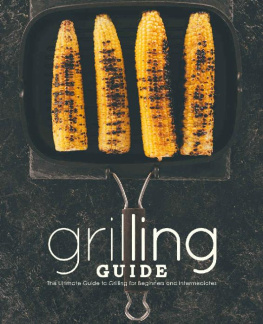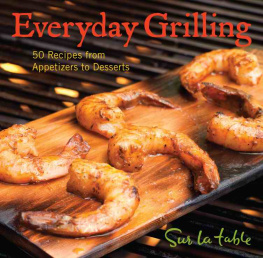

Copyright 2011, 2016 Rick Browne All rights reserved. No part of this book may be reproduced or transmitted in any form or by any means, electronic or mechanical including photocopying, recording, or by any information storage or retrieval system without express written permission from the publisher. All internal photos copyright 2010 by Rick Browne, Wishing Wells Productions, All Rights Reserved. Front cover photos (clockwise from top left of front cover): Brent Hofacker/Veer; Rick Browne; Rick Browne; lidante/Veer; Rick Browne; Peteer/Veer. Spine photo: Peteer/Veer. Back cover photo: Brent Hofacker/Veer.
Second edition, May 2016 ISBN-13: 978-1-57284-782-8 The Library of Congress has cataloged previous editions of this book as follows: Browne, Rick 1,001 best grilling recipes: delicious, easy-to-make recipes from around the world / by Rick Browne. p. cm. Summary: Over 1,000 grilling recipes from around the world for everything from appetizers to desserts. Includes sauces, marinades, and rubs--Provided by publisher. 1. 1.
Barbecuing. 2. International cooking. 3. Cookbooks. Title. II. II.
Title: One thousand and one best grilling recipes. III. Title: One thousanda one best grilling recipes. TX840.B3B759 2011 641.76--dc22 2011006340 20 19 18 17 16 10 9 8 7 6 5 4 3 2 1 Surrey Books is an imprint of Agate Publishing, Inc. Agate and Surrey books are available in bulk at discount prices. For more information, go to agatepublishing.com.
DEDICATION This book is dedicated to and honors Chef Mike Barret, an incredibly dedicated husband; a proud father of four beautiful children; an honest, decent, humble, and caring man; an extremely talented executive chef; as he called himself on his business card, the Superior Intergalactic Grand Chef of the Universe; and, to me, a dear, dear friend. He loved his family, his church, his friends, his coworkers, and life itself. Well miss his smile, his wry sense of humor, his passion for excellence, his zest for life, and, of course, his remarkable talents in the kitchen.  Table of Contents
Table of Contents
Guide
CONTENTS ACKNOWLEDGMENTS While traveling around the U.S. and through 26 countries during the past 9 years, Ive met hundreds of people who Id like to thank for helping my barbecue pilgrimage along and for their help in writing this barbecue tome. The following list contains but a few of the folks to whom Im indebted for their help, cooking tips, support, recipes, advice and friendship.
Al Roker, Today Anne & Terry Callon Anne & Kary Goodwin Ardie Davis, aka Remus Powers Aunt Linda Doden Barb, Jim, Abby, Anthony, Tyler & Betsy Smith Barbara Johnson & Tom Ryll Bruce Jacobson, Canadian Barbecue Smokers Association Bruce & Pam Paris Campbell Brown, Today Carlene & Mitch Phelps, barbecuenews.com Carol Ladd, Portland Carolyn Wells, Kansas City Barbecue Society Dan Macey, Philadelphia Dave DeWitt, fiery-foods.com Dave Hentosh, Smoldering Lake Outfitters Dennis Hayes Donna Myers, Hearth, Patio & Barbecue Association Dorothy & Arnold Browne Doug & Joyce Spittler Doug Mosley, National Barbecue News Doug Seibold, Agate Publishing Eileen Johnson, Agate Publishing Garrett Bess, Two River Pictures Geoff Latham, NickyUSA Grant & June Browne Greg & Susan Gilbert Jack and Cheryl Lawrence Jack Rogers, Jim Minion, The Car Dogs Jamie Gwen, Chef Jamieson Fuller Jennifer Lyons John Davis Jordan Asher Kara & Stephen Petersen Kate & Chris Browne Katie Couric, Today Kim Hemphill & Kim Schafer Karen Adler, Pig Out Publications Kelly Ripa Linda & Bob Buckley Lisa Miller Lois Manno, |fiery-foods.com Lyn Johnson Lynn & Jeff Shivers, IBCA Kevin, Amber & Stephen Lynch Marie Haycox, New York City Mark Mathias, Beaches Marsha Matta, Baxters Mom Martin Yan Matt Lauer, Today Michael Gelman Michelle Rousseau Nathan Wu & Karen Kulm Patty Anderson Browne Perrin Davis, Agate Publishing Peter Reinhart Regis Philbin Richard & Amanda, Little House Digital Rick & Jennifer Browne Robert & Marti Browne Rocky Danner, National Barbecue News Rubie Lloyd, ChefWear Sandy & Ken Calllon Scott Mendel Scott Stewart, The High Lonesome Ranch Smudge Browne Stephen Marsden Suzanne Rousseau-Bernard Terry Browne Tony Lyons Tricia & Reed Kawahara The Columbian Photogs: Milan Chuckovich, Kim Blau, Jerry Coughlan, Linda Lutes, Dave Olson, Janet Mathews, and Steve Lane Zoe Miller, Oregon Spice Company This book is a collection of recipes Ive gathered over ten years of roaming around the United States, Canada, Mexico, and twenty-three other countries. It has been an endless pursuit of the worlds best barbecue and grilling recipesterms, by the way, that I use interchangeably, much to the chagrin of some barbecue purists. But to me, if you cook food outdoors using wood, charcoal, natural gas, propane, or just about any other combustible materials, youre barbecuing. The only measure of success or failure is how the end productthat steak, chicken breast, fish fillet, side dish, or even desserttastes when youve finished your culinary endeavors. I wish to extend my thanks to the hundreds of wonderful people Ive met in my travels who freely shared their ideas, cooking and barbecuing tips, techniques, experiences, and recipes so I could to pass them on to others. To all Ive met, worked with, worked for, cooked with, and cooked for, I say a big and hearty...
ThankQUE! Rick Browne, PhB (Doctor of Barbecue) Indirect Cooking A technique that many barbecue chefs use, and that I use throughout this book, is to cook everything with indirect heatthereby cooking everything low and slow. This technique uses a temperature of 180F (85C) to 240F (115C) for the low part of the equation and a cooking time of 2 to 24 hours for the slow part. Obviously, the 2 hours is for pork ribs, fish, or small roasts, and the 24 hours is for tough beef briskets, large roasts, and whole birds. The best way to do this is to use a combination of direct grilling over the hottest part of the grill and indirect grilling, moving the food to an unheated or cooler part of the grill and cooking it slowly, thereby keeping it juicy, tender, and loaded with taste. To create the indirect heat effect when using coals, briquettes, or wood pieces, place them on one side only on the bottom of the barbecue. Leave the other half of the bottom empty (for now) and start your fire as you normally would.
When the barbecue is up to temperature (and the coals are covered with a thin film of white ash), place a 9 12-inch (22.5 32.5-cm) metal or foil pan on the empty side of the grill, then fill the pan with 1 to 2 inches (2.5 to 5 cm) of water. Refill the pan as the water evaporates during cooking. I recommend starting meat, poultry, and fish on the direct, hot side of the grill. This way, you can sear the food over high heat, trapping in its natural juices. Depending on the type of food, its thickness, and the fire temperature, you should only need to cook the food for a short time2 to 10 minutes, on averageon each side. (Cooler is a relative term here; the hot side of the grill may be at 600F [315C] to 700F [370C] while the cool side may be as high as 400F [200C] to 500F [260C], or thereabouts.) In most cases, a temperature of 200F (100C) to 250F (120C) is a good target for the unheated side. (Cooler is a relative term here; the hot side of the grill may be at 600F [315C] to 700F [370C] while the cool side may be as high as 400F [200C] to 500F [260C], or thereabouts.) In most cases, a temperature of 200F (100C) to 250F (120C) is a good target for the unheated side.











 Copyright 2011, 2016 Rick Browne All rights reserved. No part of this book may be reproduced or transmitted in any form or by any means, electronic or mechanical including photocopying, recording, or by any information storage or retrieval system without express written permission from the publisher. All internal photos copyright 2010 by Rick Browne, Wishing Wells Productions, All Rights Reserved. Front cover photos (clockwise from top left of front cover): Brent Hofacker/Veer; Rick Browne; Rick Browne; lidante/Veer; Rick Browne; Peteer/Veer. Spine photo: Peteer/Veer. Back cover photo: Brent Hofacker/Veer.
Copyright 2011, 2016 Rick Browne All rights reserved. No part of this book may be reproduced or transmitted in any form or by any means, electronic or mechanical including photocopying, recording, or by any information storage or retrieval system without express written permission from the publisher. All internal photos copyright 2010 by Rick Browne, Wishing Wells Productions, All Rights Reserved. Front cover photos (clockwise from top left of front cover): Brent Hofacker/Veer; Rick Browne; Rick Browne; lidante/Veer; Rick Browne; Peteer/Veer. Spine photo: Peteer/Veer. Back cover photo: Brent Hofacker/Veer.  Table of Contents
Table of Contents